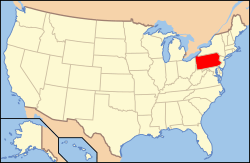Wilson Eyre
Wilson Eyre, Jr. (October 30, 1858 – October 23, 1944) was an American architect, teacher and writer who practiced in the Philadelphia area. He is known for his deliberately informal and welcoming country houses, and for being an innovator in the Shingle Style.
Wilson Eyre, Jr. | |
|---|---|
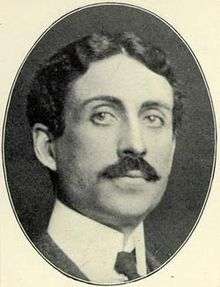 | |
| Born | October 30, 1858 Florence, Italy |
| Died | October 23, 1944 (aged 85) Philadelphia, Pennsylvania |
| Nationality | American |
| Occupation | Architect |
| Buildings | Charles Lang Freer House University of Pennsylvania Museum (with Frank Miles Day and Cope & Stewardson) |
Architect and author
The son of Americans living abroad, he was born in Florence, Italy, and educated in Europe, Newport, Rhode Island, and Canada. He studied architecture briefly at the Massachusetts Institute of Technology, joined the Philadelphia offices of James Peacock Sims in 1877, and took over the firm on Sims’s death in 1882. In 1911, he entered into partnership with John Gilbert McIlvaine, and opened a second office in New York City. The firm of Eyre & McIlvaine continued until 1939.[1]
For his most important early houses, "Anglecot" (1883) and "Farwood" (1884–85), he used a simple plan: a line of asymmetrical public rooms stretching along a single axis, extending even outside to a piazza. Like many Shingle Style architects, he employed the open "living hall" as an organizing element: all of the main first floor rooms connecting to the hall, often through large openings. In addition, he used staircases to extend the space of the hall to the second floor. According to architectural-historian Vincent Scully: "This sense of extended horizontal plane and intensified "positive" scale evident in Eyre's work becomes later a basic component in the work of [Frank Lloyd] Wright..."[2] Eyre collaborated with artists such as Alexander Stirling Calder and Louis Comfort Tiffany.
Following his early success, Eyre became a leader in the international country life movement, lecturing in England, and corresponding with British and German architects. He was one of the first U.S. architects to be featured in the Arts & Crafts magazine International Studio, and he was published by Hermann Muthesius, the chronicler of the so-called "English" house of the turn of the century. Prior to Frank Lloyd Wright's rise to prominence, Eyre was arguably the best-known domestic architect in the U.S. among foreign designers. His post-1890 country houses, such as "Allgates" (1910, expanded by Eyre & McIlvaine 1917) are among the most accomplished American essays in the restrained stucco cottage idiom popularized by C.F.A. Voysey and Ernest Newton in England.[3]
He was one of the founders and editors of House & Garden magazine.[1] He designed many distinctive gardens with his residences, and wrote extensively of the need for interaction between rooms and outdoor spaces.
He was also renowned for his distinctive artistic drawings, often in watercolor. His extant drawings are now housed in the Architectural Archives of the University of Pennsylvania. He was elected a Fellow of the American Institute of Architects in 1893. In August 1914 Eyre was stranded in Europe along with thousands of Americans attempting to escape the fighting that erupted in World War I. Eyre returned to the United States in late September and shared a cabin with Augustus P. Gardner, a member of the House of Representatives from Massachusetts.[4]
In 1917, he was awarded the Gold Medal of the Philadelphia Chapter of the American Institute of Architects. He taught at the University of Pennsylvania, and was one of the founders of the T Square Club of Philadelphia in 1883.[1] In 1910, he was elected into the National Academy of Design as an Associate Academician.
He died in Philadelphia and is interred at The Woodlands Cemetery.[5]
Selected works
Philadelphia area
Residences
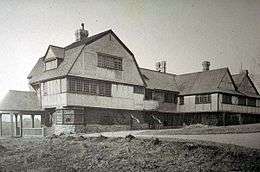
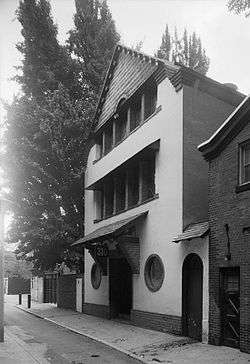
- "Anglecot" (Charles Adams Potter house), 401 E. Evergreen Avenue, Chestnut Hill, Philadelphia, Pennsylvania (1883).[6][7] Added to the National Register of Historic Places in 1982.
- "Farwood" (Richard L. Ashurst house), Overbrook, Pennsylvania (1884–85, demolished).[8]
- 220 Glenn road, Ardmore, PA, 19003[9]
- "Wisteria" (Charles A. Newhall house), 444 W. Chestnut Hill Avenue, Chestnut Hill, Philadelphia, Pennsylvania (1884–85).[10]
- Dr. Henry Genet Taylor House and Office, 305 Cooper Street, Camden, New Jersey (1884–86).[11] As of January 2015, renovation was underway by Rutgers University–Camden to convert the building into a Writers House.[12]
- Harriet D. Schaeffer house, 433 W. Stafford Street, Philadelphia, Pennsylvania (1888)[13]
- Sally Watson House, 5128 Wayne Ave., Philadelphia, Pennsylvania (1889).
- Clarence B. Moore House, 1321 Locust Street, Philadelphia, Pennsylvania (1890).[14]
- Henry Cochran house, 3511 Baring Street, Philadelphia, Pennsylvania (1891).[15]
- Neill-Mauran House, 22nd & Delancey Streets, Philadelphia, Pennsylvania (1891).[16]
- Dr. Joseph Leidy House and office, 1319 Locust Street, Philadelphia, Pennsylvania (1894).[17]
- Mrs. Evan Randolph house, 218 W. Chestnut Hill Avenue, Chestnut Hill, Philadelphia, Pennsylvania (1906).[18]
- Clover Hill Farm, 910 Penn Valley Rd Media, Pennsylvania (1907).
- Alterations to Wilson Eyre House, 1003-05 Spruce Street, Philadelphia, Pennsylvania (1909–1910). It was added to the National Register of Historic Places in 1977.[19]
- "Allgates" (Horatio Gates Lloyd mansion), Coopertown Road, Haverford, Pennsylvania (1910, expanded by Eyre & McIlvaine 1917). Added to the National Register of Historic Places in 1979.
- Additions to "Bel Orme" (Thomas Mott house), Matson Ford & County Line Roads, Radnor, Pennsylvania (Eyre & McIlvaine) (1917).[20]
Other buildings
- Mask & Wig Clubhouse, 310 Quince Street, Philadelphia, Pennsylvania (1894, altered by Eyre 1901).[21] Murals by Maxfield Parrish. Added to the National Register of Historic Places in 1979.
- University of Pennsylvania Museum, 3260 Spruce Street, Philadelphia, Pennsylvania (with Frank Miles Day and Cope & Stewardson) (1895–99).
- Corn Exchange Bank, Northeast corner 2nd & Chestnut Streets, Philadelphia, Pennsylvania (1896).[22]
- Carnegie Library, McPherson Square, 601 E. Indiana Avenue, Philadelphia, Pennsylvania (Eyre & McIlvaine) (1915–17)[23]
- Swann Memorial Fountain, Logan Circle, Philadelphia, Pennsylvania (Eyre & McIlvaine, architects; Alexander Stirling Calder, sculptor) (1921–24).
- The St. Anthony Club of Philadelphia. 32 South 22nd Street, Philadelphia, Pennsylvania. 1888.
Other regions
Residences
- Charles Lang Freer House, 71 E. Ferry Street, Detroit, Michigan (1890). Eyre altered the carriage house in 1906, to install The Peacock Room by James McNeill Whistler (now in the Freer Gallery, Washington, DC). Added to the National Register of Historic Places in 1971.
- Nathan Franklin Barrett house, "26, The Boulevard", Rochelle Park, New Rochelle, New York (1890).[24] Barrett was the landscape architect and planner of the Rochelle Park community.
- "Greyeres" (Ernest Albert mansion), 9 Manhattan Avenue, Rochelle Park, New Rochelle, New York (1896, demolished).[24]
- "Meadowcroft" (Theodore E. Conklin mansion), Southampton, Long Island, New York (1904).[25] Lighting by Louis Comfort Tiffany.
- E.S. Sands mansion, Southport, Connecticut (1905)[26]
- "Etowah" (George W. King house), 429 Mt. Vernon Ave, Marion, Ohio (1908). Added to the National Register of Historic Places in 1995.
- "Northcote" (Stephen Parrish house), Lang Road, Cornish, New Hampshire (1893).[27] Located near the Cornish Art Colony, this became the home/studio of the client's son, the painter Maxfield Parrish
Other buildings
- Detroit Club, 712 Cass Avenue, Detroit, Michigan (1891). Added to the National Register of Historic Places in 2005.
- Newcomb College Memorial Chapel, 6th & Chestnut Streets, New Orleans, Louisiana (1894–95, demolished 1954). Stained glass by Louis Comfort Tiffany.
Image gallery
- "Anglecot" (Charles Adams Potter house), 401 E. Evergreen Ave., Chestnut Hill, Philadelphia (1883).
 Dr. Henry Genet Taylor House and Office, 305 Cooper St., Camden, NJ (1884–86).
Dr. Henry Genet Taylor House and Office, 305 Cooper St., Camden, NJ (1884–86).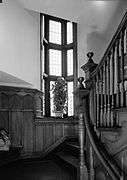 Interior of Taylor house (1884–86).
Interior of Taylor house (1884–86). Harriet D. Schaeffer house, 433 W. Stafford St., Philadelphia (1888).
Harriet D. Schaeffer house, 433 W. Stafford St., Philadelphia (1888).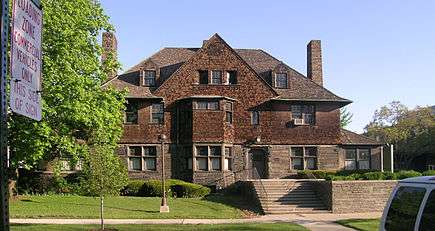 Charles Lang Freer House, 71 E. Ferry St., Detroit, MI (1890).
Charles Lang Freer House, 71 E. Ferry St., Detroit, MI (1890).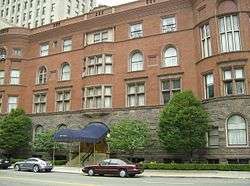 Detroit Club, 712 Cass Ave., Detroit, MI (1891).
Detroit Club, 712 Cass Ave., Detroit, MI (1891).- Doorways to Neill & Mauran Houses, 22nd & Delancey Sts., Philadelphia (1891).
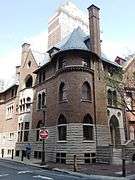 Clarence Bloomfield Moore House, 1321 Locust St., Philadelphia (1890). Eyre's Leidy House is next door (right).
Clarence Bloomfield Moore House, 1321 Locust St., Philadelphia (1890). Eyre's Leidy House is next door (right).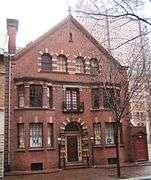 Dr. Joseph Leidy, Jr. House & Office, 1319 Locust St., Philadelphia (1894).
Dr. Joseph Leidy, Jr. House & Office, 1319 Locust St., Philadelphia (1894).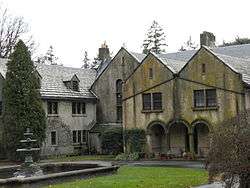 Allgates (Horatio Gates Lloyd mansion), Haverford, PA (1910, altered by Eyre & McIlvaine 1917).
Allgates (Horatio Gates Lloyd mansion), Haverford, PA (1910, altered by Eyre & McIlvaine 1917).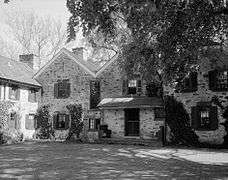 "Bel Orme" (Thomas Mott house), Radnor, PA (altered by Eyre & McIlvaine 1917).
"Bel Orme" (Thomas Mott house), Radnor, PA (altered by Eyre & McIlvaine 1917). Swann Memorial Fountain, Logan Circle, Philadelphia (1924), Eyre & McIlvaine, architects; Alexander Stirling Calder, sculptor.
Swann Memorial Fountain, Logan Circle, Philadelphia (1924), Eyre & McIlvaine, architects; Alexander Stirling Calder, sculptor.
References
- Wilson Eyre Biography at Philadelphia Architects and Buildings
- Vincent J. Scully, Jr. The Shingle Style and the Stick Style (New Haven, CT: Yale University Press, 1955, revised 1971), p. 124, figs. 97, 98, 100 & 101.
- See Mark Alan Hewitt, The Architect and the American Country House, 1890-1940 (New Haven, Yale Univ. Press: 1990): pages 25-67.
- Constance Gardner, ed., Some Letters of August Peabody Gardner (Boston: Houghton Mifflin, 1920), 91.
- "Wilson Eyre, Jr". www.findagrave.com. Retrieved 6 April 2019.
- Anglecot at Bryn Mawr College
- "Anglecot" plan & photos at University of Pennsylvania
- "Farwood" plan & photos at University of Pennsylvania
- Original drawings current owner
- Newhall house at Chestnut Hill Historical Society
- Taylor House at Historic American Buildings Survey
- Jonathan Lai, "At Rutgers-Camden, new Writers House in works," The Philadelphia Inquirer, January 12, 2015.
- [Schaeffer House] at Historic American Buildings Survey
- Clarence Moore house (left) at Bryn Mawr College
- Cochran house at University of Pennsylvania
- Neil and Mauran houses at University of Pennsylvania
- Joseph Leidy house (right) at Bryn Mawr College
- Randolph house at Chestnut Hill Historical Society
- "National Register Information System". National Register of Historic Places. National Park Service. July 9, 2010.
- "Bel Orme" at the Historic American Buildings Survey
- "Mask & Wig". Maskandwigrentals.wordpress.com. Retrieved 2013-03-12.
- Corn Exchange Bank at Bryn Mawr College
- McPherson Square Library at Library Company of Philadelphia
- "Rochelle Park/ Rochelle Heights Historic District". Retrieved 2013-03-12.
- "Meadowcroft" at Philadelphia Architects and Buildings
- "Sands mansion plan & photos". Housemouse.net. Retrieved 2013-03-12.
- "Parrish House". Crjc.org. 1938-05-15. Retrieved 2013-03-12.
External links
- Wilson Eyre architectural drawings and papers, circa 1877-1945.Held by the Department of Drawings & Archives, Avery Architectural and Fine Arts Library, Columbia University.
- Wilson Eyre at Find a Grave
- Wilson Eyre Collection, Weitzman Archives, University of Pennsylvania.

